Daedric Princes (sometimes referred to as Daedra Lords) are the most powerful of the Daedra and thus most commonly worshipped as deities. While Daedra can manifest as either male or female (being in reality genderless), all of these high Daedra are typically referred to as "Princes".[1][2]
Throughout the series, a number of Daedric Princes, along with the other worshipped gods, play a major part in the events of a game's main storyline. In all, there are sixteen widely known Princes[3](a "seventeenth" prince, Jyggalag, was expanded upon in the Shivering Isles questline as the original form of the prince Sheogorath).[4] As with all Daedra, Daedric Princes operate on a different plane of existence than humans and other mortals, and as such possess an incomprehensible concept of 'morality'; it is for this reason that none of the Daedric Princes can be considered objectively "evil". However, a number of them have been known to consistently inflict harm on the inhabitants of Tamriel, leading to most being considered sinister by mortal standards.
Every Daedric Prince has his/her own Oblivion.[3]
Azura
Statue of Azura in Skyrim
Azura is the Daedric prince whose sphere is dusk and dawn, the magic in-between realms of twilight. Azura is always depicted as a female, and is also known as "Mother of the Rose," "Queen of the Night Sky," and the Anticipation of Sotha Sil.[1] Azura is usually represented by her artifact, Azura's Star, a reusable soul gem that can be found in Morrowind, Oblivion and Skyrim.[1][2] Azura is one of the few Daedra who might be considered "good" by mortal standards, due to her concern for her followers' well-being. Azura's plane is known as Moonshadow, a realm said to be too beautiful for mortals to comprehend.
It was Azura who told Nerevar that Dagoth Ur's knowledge of the Heart of Lorkhan was accurate. This caused a war with the Dwemer (whose king denied knowledge of the Heart, although Azura only denied it due to lack of her own personal knowledge of the subject), from which Nerevar emerged the victor, and the Dwemer did not emerge at all. Later, when the Tribunal of Vivec, Almalexia and Sotha Sil used the power of the Heart of Lorkhan to make themselves gods (and thus breaking their oath to Azura), Azura cursed the Chimer (which caused their skin to turn a dark greyish color and their eyes to turn red, thus making them Dunmer, or Dark Elves)[5] and claimed that she would cause Nerevar to be reborn and that she would make things right again. Later, Azura aided the Nerevarine in defeating Dagoth Ur and toppling the Tribunal Temple (due to the differing accounts, told by various factions and individuals in Morrowind, this should be taken with a grain of salt). Azura is also credited for making the Khajiit from Bosmer stock in Elsweyr.
Boethiah
Boethiah's Shrine in The Elder Scrolls IV: Oblivion
Boethiah is the Prince of Plots, who rules over deceit, conspiracy, secret plots of murder, assassination, treason, and unlawful overthrow of authority. Boethiah is depicted as an (often female) great caped warrior, often in a stoic pose and is also known as the Anticipation of Almalexia. Attribution’s Share is the Plane of Boethiah; she frequently holds the Tournament of Ten Bloods in said Plane.
Boethiah loves competition and battle, and this nature is manifested in her quest in Oblivion,[2] transporting the player to her realm of Oblivion for a tournament to decide who is truly worthy of Goldbrand, an enchanted katana with a gold-colored blade (rebuilding her shrine near Khartag Point in Vvardenfell is enough to claim the blade in Morrowind).[1] The infamous Pillow Book is also named in her honor.
Heralded by the Prophet Veloth, Boethiah is the original god-ancestor of the Dunmer. Through her illuminations, the eventual 'Chimer,' or Changed Folk, renounced all ties to the Aldmer and founded a new nation based on Daedric principles. All manner of Dark Elven cultural 'advances' are attributed to Boethiah, from philosophy to magic to 'responsible' architecture.
Clavicus Vile
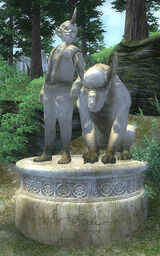
Clavicus Vile's Shrine in The Elder Scrolls IV: Oblivion
Clavicus Vile is the Daedric prince whose sphere is the granting of power and wishes through ritual invocations and pact. Clavicus has a companion named Barbas. While capable of selective shape-shifting, the form it assumes most of the time is that of a dog (although dialogue from Oblivion states that one of the forms he took was a "scamp who made deals with orcs"),[2] a possible reference to an easter egg named "Creeper" from Morrowind.[1] Clavicus himself is depicted as a jovial fellow with horns protruding from his forehead.
In the past, Clavicus Vile has worked through mortal representatives to gain what he desires. In the game Redguard, Vile gambled with the protagonist Cyrus for the soul of Cyrus' sister against Cyrus' own soul.[6] In Morrowind, the player may obtain Clavicus Vile's artifact, the Masque of Clavicus Vile, by defeating a Nord sorcerer who has been terrorizing the village of Dagon Fel.[1] In Oblivion, the Masque may be acquired by finding and returning the sword Umbra to Vile.[2] In Skyrim, the Masque is obtained from Clavicus Vile after helping it acquire the Rueful Axe (during which, the player may choose to kill Barbas or not.
Clavicus Vile's shrine in Skyrim.
If the player kills Barbas, the Rueful Axe may be kept. If not, the player gets the mask and loses the Axe). Another artifact associated with Clavicus Vile is the Bitter Cup. In Morrowind the player is able to trade this cup with a Clavicus Vile worshiper in order to gain political support.[1] In the Oblivion "Vile Lair" plugin, the book "Manifesto Cyrodiil Vampyrum" states that Molag Bal and Clavicus Vile are the patrons of Cyrodiil's clan of vampires.[7]
Hermaeus Mora
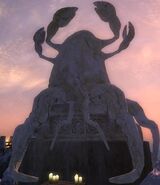
Hermaeous Mora's Shrine in Oblivion
Hermaeous Mora in Skyrim
Hermaeus Mora is the Daedric Prince of knowledge and memory. His sphere is the scrying of the tides of fate, of the past and future as read in the stars and heaven, and in his dominion are the treasures of knowledge and memory. His realm is known as the "Apocrypha," an endless library where all forbidden knowledge may be found.
Hermaeus Mora's appearance is probably the most bizarre and perplexing of all of the Daedric Princes; most commonly, he represents himself as a rotund mass of tentacles with an abundance of eyes and four disproportionately large lobster-like claws. In Skyrim, he appears as a purple and black void. In all appearances, Hermaeus Mora has a deep, menacing voice.
He may be the "Woodland Man" of Nedic myth who catches villagers lost in the woods; the secondary set of his name, Mora, is one word for "wood," "woodland," or "tree(s)" in Elvish. His artifact, the Oghma Infinium, is an ultimate skill book that selectively improves character traits.
Hircine

Statue of Hircine in Oblivion
Hircine is the Daedric prince whose sphere is the Hunt, the Sport of Daedra, the Great Game, and the Chase; he is known as the Huntsman and the Father of Manbeasts.[3] Hircine created the various lycanthropic diseases which transform mortals into beasts,[8] and is, therefore, the guardian of were-creatures. They reflect his sphere admirably, hunting at night and being hunted by day. Hircine is a sportsman who enjoys giving his prey a chance for victory, however small. Hircine's statue depicts him as a physically fit man whose whole head is obscured by a deer skull with long antlers. He is armed with a great spear and has a companion wolf. Hircine's typical lackeys on the mortal realm, Nirn, are werewolves, which he directly talks to, and to whom he gives tasks and rewards with additional powers. The lesser Daedra, Herne, are also affiliated with him.
In The Elder Scrolls Legends: Battlespire, the protagonist was forced to endure a hunt in Hircine's realm.[9] In The Elder Scrolls III: Bloodmoon expansion, the Nerevarine was forced to defeat an aspect of Hircine (that of strength, speed, or guile) at the end of the Bloodmoon hunt. In The Elder Scrolls IV: Oblivion, he sends the protagonist on a hunt for a unicorn's horn. In The Elder Scrolls V: Skyrim, he is involved in the quest Ill Met By Moonlight.
Malacath
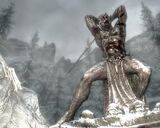
Statue of Malacath in Skyrim
Malacath is the Daedric prince whose sphere is the patronage of the spurned and ostracized, the keeper of the Sworn Oath, and the Bloody Curse.[10]
He was created when Boethiah ate the Aedra Trinimac, causing the Orsimer ("Pariah Folk" in Elvish) or Orcs to be created, as they were Trinimac's devout followers.[11]Malacath is not recognized as a Daedric Prince by his peers, which fits his sphere perfectly. Malacath is also called Malauch by Orcs and Orkey or the Old Knocker by Nords, who blame him for stealing mankind's long lifespans.[11] Malacath spurns physical weakness; hence, the above-average strength of the creatures associated with him.[12]
In Morrowind, Malacath's quest is one of revenge for an Orc.[1] In Oblivion a player can visit Malacath's shrine; his quest is one of freeing enslaved ogres.[2] Malacath's statue is a muscular Orc ready to strike with a heavy weapon. Malacath's artifact is a massive Dwemer warhammer known as Volendrung.
In Morrowind, Malacath is known as one of the "Four Pillars of the House of Troubles," or as the "bad Daedra."[1]In Skyrim, he is most commonly referred to as "Orkey," or "Old Knocker."
The Ashpit is Malacath's realm and is known as the hardest of the realms to reach, save the ones that are completely inaccessible to mortals. The Ashpit is described as consisting only of dust, palaces of smoke, and vaporous creatures.
Mehrunes Dagon

Shrine of Mehrunes Dagon in Skyrim.
Mehrunes Dagon is the Daedric Prince of Destruction, Change, Revolution, Energy, and Ambition. He is associated with natural dangers like fire, earthquakes, and floods. He is an especially important deity in Morrowind, where he represents its near-inhospitable terrain.[12] In most cultures, however, Dagon is merely a god of bloodshed and betrayal. Dagon's plane of Oblivion is known as "The Deadlands" and is featured in The Elder Scrolls IV: Oblivion.[2]
Of all the Daedric Princes, Mehrunes Dagon seems to have the most animosity towards Nirn's species. Given his nature (Prince of Destruction), along with the fact that Daedra truly cannot be destroyed, the only entities he can practice destruction on are mortals. He assisted Jagar Tharn in his temporary usurpation of the Imperial throne. He invaded and seized control of the Battlespire[13]in violation of the Daedric pact[13] and preventing unchecked meddling in mortal affairs by divine beings[13])the purpose of this being to cripple the capacity of the Imperial College of Battlemages, which presented a threat to Tharn's power as Emperor[13]),
Mehrunes Dagon was also responsible for the destruction of Mournhold at the end of the First Era[13] and apparently also destroyed Ald Sotha[13], home of House Sotha[13] and Sotha Sil's birthplace.[13] In Oblivion, the plot centers around a plot by Dagon's followers to destroy the Septim bloodline and Tamriel in general.[2]
At the end of Oblivion, the Avatar of Akatosh destroys Dagon's physical body, sending Dagon back into the Waters of Oblivion.[2]
- In The Elder Scrolls III: Morrowind, Mehrunes Dagon is known as one of the "Four Corners of the House of Troubles," which consists of the Daedra the citizens of Morrowind consider the "bad Daedra," or the malevolent Daedra Princes that cause destruction in Tamriel.
- In The Elder Scrolls IV: Oblivion, he's the only Daedric Prince who doesn't offer the player a side quest (given his status as the game's antagonist).[2] His trademark artifact, "Mehrunes' Razor," may be found in an official plug-in, however.[2]
Mephala
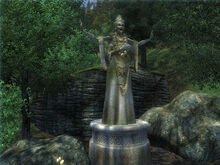
Statue of Mephala
Mephala is a Daedric Prince whose sphere is obscured to mortals, also known by the names Webspinner, Spinner, Spider, and the Anticipation of Vivec.[14] The only consistent themes seem to be interference in the affairs of mortals for her amusement, and spiders. She also directly helped to found the infamous cult/society of the Morag Tong.[15][16] Her sphere seems to indicate a careful plan carried out through executions, each life a portion of a massive web. Mephala sees the affairs of mortals as a weave; pull but one thread and the entire web unravels. Her quest in Oblivion involves inciting a peaceful town into anarchy.[2] In Skyrim, the Ebony Blade is received from her. Her realm is known to be completely inaccessible to mortals.
Meridia
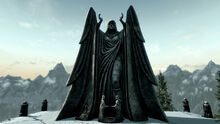
Statue of Meridia
Meridia is an obscure Daedric Prince to mortal eyes, and very little is known about her. She is associated with the energies of living things, and bears a special hatred for the undead. Her realm is known as the Colored Rooms.
In Oblivion, she presents the Hero of Kvatch with a quest to destroy Necromancers who are raising an army of the undead. Meridia is rumored to be Aedric in origin but banished for a misuse of magic.[2]
In the The Elder Scrolls IV: Knights of the Nine plugin, the Ayleid sorcerer king Umaril the Unfeathered was revealed to have made a pact with Meridia.[17] This pact allowed Umaril to cheat death after his defeat at the hands of Pelinal Whitestrake by escaping into Meridia's realm in Oblivion and returning to the mortal world. It would also allow him command over Meridia's daedra, the Aurorans.[17]
In Skyrim, Meridia tasks the Dragonborn with returning a beacon to her statue, guiding a beam of light through her shrine, and finally slaying the necromancer Malkoran and his attendant Corrupted Shades in the quest, The Break of Dawn. For these efforts the player is rewarded with the sword Dawnbreaker, designed to destroy undead in accordance with Meridia's sphere of influence.
Molag Bal

Molag Bal is the Daedric Prince whose sphere is the domination and enslavement of mortals. His only desire is to harvest the souls of mortals and to bring mortals' souls within his sway by spreading seeds of strife and discord in the mortal realms. As mentioned above, this is not evil. His realm is called "Coldharbour,"[3] a twisted dark version of Tamriel.
Molag Bal is said to be the father (along with Vivec, whom he seduced[18]) of a population of mutant degenerates living in the region of Morrowind bearing his name, who may have been the first eventual vampires[18], a corruption of Vivec's ties to the Heart of Lorkhan transmitted to mortals[7]. However, some other cultures disagree with that theory, claiming the creation of vampires to be in Skyrim.[7]
It should be noted, however, that Molag Bal helps the player cure his vampirism (if it has been contracted) in Morrowind. In exchange, the hero must track down Molag Bal's daughter and kill her.[1] There is also another Molag Bal mission, at a shrine on an island east off the coast of Vvardenfell. The player must kill his lazy servant Menta Na in his lair east of Kogoruhn in the Ashlands region. If the hero completes this task, he/she is awarded the unique Mace of Molag Bal. The mace may also be acquired in Oblivion and Skyrim — in Oblivion, after a quest requiring the player to let a man named Melus kill them with a cursed mace,[2]and in Skyrim, after a quest requiring the player to slay a priest of Boethia at his shrine in an abandoned house for desecrating it.
In a book from the Oblivion "Vile Lair" plugin, one of the other vampire creation myths is given. Molag Bal, in a rage against Arkay, the god of life and death, set out to disrupt the cycle. He ravaged a Nedic virgin named Lamae in Skyrim, and her screams became the winds.[7] He pricked his finger and left a drop of his corrupting blood on the center of her forehead. She awoke as the mother of vampires as she was burning on a funeral pyre. She slaughtered the funeral procession, and her "unholy" progeny spread to every corner of Tamriel, much to the despair of Arkay, incapacitated by the creation of Nirn.[7]
- In Morrowind, Molag Bal is known as one of the "Four Pillars of the House of Troubles,"[1] known in Morrowind as the "Bad Daedra."
- Molag Bal has a shrine in Skyrim in the Abandoned House in Markarth. As a reward for freeing a priest and beating him into submission twice and then slaughtering him at Molag's altar, the player obtains the Mace of Molag Bal. During this quest, Molag Bal states that Boethiah is his rival.
Namira
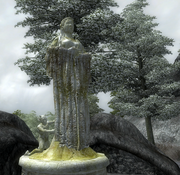
Namira in Oblivion
Namira is the Daedric Prince whose sphere is the ancient darkness.[10] She is associated with all things generally considered repulsive, including various creatures such as spiders or slugs and disease that cause any kind of unattractive physical abnormalities. Namira's followers keep to themselves and prefer living peacefully in dark and squalid conditions but will react violently at any attempts to "save" them from their abysmal, minimalistic lifestyles. Her quest in Oblivion involves working with outcasts to ambush a group of priests under Arkay who attempt to "save" Namira's dark followers.[2]
In Skyrim, the Dragonborn has an indirect meeting with Namira in Markath's Hall of the Dead. Eola, a cannibal, asks the Dragonborn to accompany her to a cave where they must lure a priest of Arkay to Namira's shrine and eat him. When he is consumed, Namira has a short conversation with the Dragonborn about how pleased she is at them eating a priest of Arkay. They receive Namira's ring, an artifact that restores health and stamina when "feasting" on slain enemies.
Nocturnal
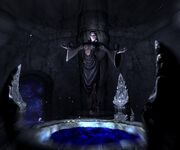
Nocturnal (Skyrim)
Nocturnal is the Daedric Mistress whose sphere is the night and darkness, also known as the Night Mistress. The Cyrodilic Thieves Guild leader, The Gray Fox, has the Cowl of Nocturnal[2], which truly represents the sphere's darkness quality; it permanently removes the wearer's specific identity from all history. According to an account of a Blind Moth Priest[2], this is to prevent anyone from remembering the face of Nocturnal, for to do so would be to go insane.[2]
Nocturnal's second artifact is the Skeleton Key,[19] an unbreakable lockpick that allows even unskilled users to pick the most complicated locks. Both the Hero of Kvatch and the Dragonborn might have obtained this artifact from her. In Skyrim, the Dragonborn has the ability to gain entrance into her secretive cult of Nightingales. Upon returning the Skeleton Key, she awards them with one of three special abilities reserved for Nightingales. She rules over the Evergloam.
Peryite
Peryite in Oblivion
Peryite, also known as the Taskmaster, is the Daedric Prince whose sphere is Pestilence, and he is charged with ordering the lowest levels of Oblivion.[10] He is often depicted as a green Dragon[20] and is ostensibly concerned with ensuring all things are accounted for, neat, tidy, and in their proper order.
Peryite's artifact is an enchanted shield, the Spellbreaker,[19][20]which, in Oblivion, may reflect spells back to the caster and, in Skyrim, possesses the ability to create a ward against the damaging effects of spells. He is known to be one of the weakest of Daedric Princes, despite being depicted as a Dragon.
Sanguine
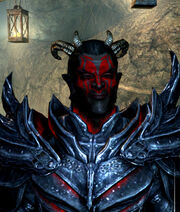
Sanguine, as he appears in Skyrim.
Sanguine is the Daedric Prince whose sphere is hedonistic revelry, debauchery, and passionate indulgences of darker natures.[10] He often appears on the seals and signs of brothels and whore-houses.
In Morrowind, it is revealed by the Grandmaster of the Morag Tong, Eno Hlaalu, that Sanguine crafted 27 items for Mephala collectively termed the "Threads of the Webspinner."[1] If the Hero collects all 27 items and returns them to Hlaalu, they receive the Mephala's Blessing spell.[1]
In Oblivion, if the player visits his shrine and gives him a bottle of Cyrodiilic Brandy, he sends the Hero of Kvatch on a quest to play a prank on a noble and her guests at a party.[2] If successful, Sanguine gives the Hero of Kvatch the Sanguine Rose, a staff that can summon a random Daedra on a target. In Skyrim, the Dragonborn can once again obtain the staff, this time by completing the quest A Night to Remember. In its Skyrim incarnation, the staff always summons a Dremora Lord.
Sheogorath

Sheogorath in the Shivering Isles.
Sheogorath is the infamous Prince of Madness, whose motives are unknowable. His realm in Oblivion is The Shivering Isles, and is served by the Golden Saints and Dark Seducers.
Sheogorath savors the act of driving mortals insane or making them perform actions that may be seen as trivial or silly.[21] Sheogorath speaks with an almost exaggerated Scottish accent in the Shivering Isles. His favored weapon for mortals is the staff Wabbajack,[22] which can transform any living NPC creature into another random creature. Another artifact known as the Staff of Everscamp, which the owner cannot discard, causes the owner to be constantly followed by four scamps.[2] There is also a region in Morrowind named after him, Sheogorad.[1] There are many Daedric shrines there, many of which are shrines built specifically for his followers to worship him. As the Madgod, Sheogorath himself considers madness to be a form of mercy for those who would otherwise not function in the world — "a bitter mercy, perhaps, but a mercy nonetheless".
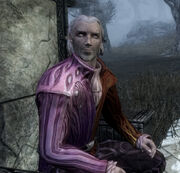
The New Sheogorath in Skyrim.
Sheogorath came into existence with Nirn as the "Sithis-shaped hole in the world." It is learned in Shivering Isles that the other Daedric Princes feared the Daedric Prince of Order (Jyggalag) was becoming too powerful, and so they cursed him into a body of madness (Sheogorath), everything he stood against. Though Sheogorath seems to prefer this new existence and to care in his own way for the residents of the Shivering Isles, Jyggalag is nonetheless able to return at the end of every era, leading a "Greymarch" (destruction of the realm using the Knights of Order). The curse would then revert him to Sheogorath, leaving Sheogorath to once again re-assemble his realm. Not wanting to see his beloved Shivering Isles destroyed again by the Greymarch, Sheogorath called for a champion from Nirn. At the end of the 3rd Era, Jyggalag was struck down by Sheogorath's Champion.[4] With this, the Greymarch was ended prematurely, releasing Jyggalag from the cycle, and the Hero was crowned the new "Sheogorath." [4] Jyggalag says that the hero may one day grow into their new role.[4]
In Morrowind, Sheogorath is known as one of the "Four Corners of the House of Troubles."[1]
Sheogorath reappears in Skyrim in the quest, The Mind of Madness, which has an improved Wabbajack as its reward. He makes references to the Oblivion Crisis, stating that he had a personal involvement, possibly revealing that he is indeed the Hero of Kvatch.
Jyggalag
Jyggalag in Oblivion
Jyggalag is the Prince of Order, but his sphere and other characteristics were not revealed during the early Elder Scrolls games. Prior to The Elder Scrolls IV: Shivering Isles, Jyggalag had only been briefly mentioned in books such as On Oblivion[23] but had not appeared in any games. Jyggalag commands his own Daedra, the "Knights of Order," which are spawned from mysterious obelisks activated by his followers, the Priests of Order. Jyggalag and his minions are depicted as grey crystalline knights. He represents logical order and deduction, and is said to "never have had an original idea in his life."[4]
Shivering Isles reveals that Jyggalag is in fact Sheogorath himself. Jyggalag had grown in power and influence, and the other Daedric princes had grown fearful of him. They cursed him to live as Sheogorath, the incarnation of the thing he hated most — Madness. However, the other Daedric Princes wanted to make sure that Jyggalag suffered more, so he is allowed to return to his true form at the end of every era in order to retake his lands from his mad self, an event known as the "Greymarch." However, once this was done, the curse would transform him back into Sheogorath, starting the cycle over again, something that Jyggalag knew would happen every time he was finished. At the end of the Third Era, with the Greymarch occurring, the player is given the chance to defeat Jyggalag, stopping the Greymarch before it can conquer Sheogorath's territory. This releases Jyggalag from his curse, allowing him to remain in his true form and return to Oblivion. The player is then granted the role of "Sheogorath," the Prince of Madness.[4]
Vaermina

Vaermina in Oblivion
Vaermina (also spelled Vaernima) is a Daedric Prince whose sphere is the realm of dreams and nightmares, and from whose realm issues forth evil omens. Some have also claimed her sphere ties somehow to torture.[10] Vaernima is depicted as a grotesque old woman. Her plane of Oblivion is "Quagmire."[3]It is described as a nightmare realm, where every few minutes reality shifts and becomes ever more horrifying.
In The Elder Scrolls IV: Oblivion, the player is tasked with retrieving an orb of Vaermina's that was stolen by a powerful warlock held up in a remote tower. The reward item granted to the protagonist in Oblivion is the Skull of Corruption,[2] a staff imbued with the power to create a temporary evil clone of an NPC that lasts for half a minute.[2] She is credited with telling Molag Bal the cure for Vampirism in Morrowind.[1]
In Skyrim, in the quest Waking Nightmare, the player must save the people of Dawnstar from nightmares caused by Vaermina's shrine. The Skull of Corruption reappears, and may be the Dragonborn's reward, depending on his or her actions (the opportunity is clearly presented). Despite appearing in the previous game, the staff has a completely different effect.
Sources
- The Daggerfall Chronicles. Ronald Wartow. 1996. Bethesda Softworks. ISBN 0929843207
- The Imperial Library, Imperial Census of Daedra Lords. [1]*The Imperial Library, The Definitive Guide to Daedra. [2]
- The Book of The Daedra, found everywhere in The Elder Scrolls IV: Oblivion and The Elder Scrolls V: Skyrim.
References
- ↑ 1.00 1.01 1.02 1.03 1.04 1.05 1.06 1.07 1.08 1.09 1.10 1.11 1.12 1.13 1.14 1.15 The Elder Scrolls III: Morrowind
- ↑ 2.00 2.01 2.02 2.03 2.04 2.05 2.06 2.07 2.08 2.09 2.10 2.11 2.12 2.13 2.14 2.15 2.16 2.17 2.18 2.19 2.20 2.21 The Elder Scrolls IV: Oblivion
- ↑ 3.0 3.1 3.2 3.3 3.4 The Doors of Oblivion
- ↑ 4.0 4.1 4.2 4.3 4.4 4.5 The Elder Scrolls IV: Shivering Isles
- ↑ The Changed Ones
- ↑ The Elder Scrolls Adventures: Redguard
- ↑ 7.0 7.1 7.2 7.3 7.4 Opusculus Lamae Bal ta Mezzamortie
- ↑ The Elder Scrolls III: Bloodmoon
- ↑ The Elder Scrolls Legends: Battlespire
- ↑ 10.0 10.1 10.2 10.3 10.4 The Book of Daedra
- ↑ 11.0 11.1 The True Nature of Orcs
- ↑ 12.0 12.1 The House of Troubles
- ↑ 13.0 13.1 13.2 13.3 13.4 13.5 13.6 13.7 2920, Sun's Dusk, v11
- ↑ Vivec and Mephala
- ↑ The Anticipations
- ↑ Fire and Darkness
- ↑ 17.0 17.1 The Elder Scrolls IV: Knights of the Nine
- ↑ 18.0 18.1 The 36 Lessons of Vivec, Book 14
- ↑ 19.0 19.1 Tamrielic Lore
- ↑ 20.0 20.1 The Elder Scrolls II: Daggerfall
- ↑ The Elder Scrolls IV: Shivering Isles
- ↑ Wabbajack (Book)
- ↑ On Oblivion
| Daedric Princes | |
|---|---|
| Princes | |
| Related topics | |
